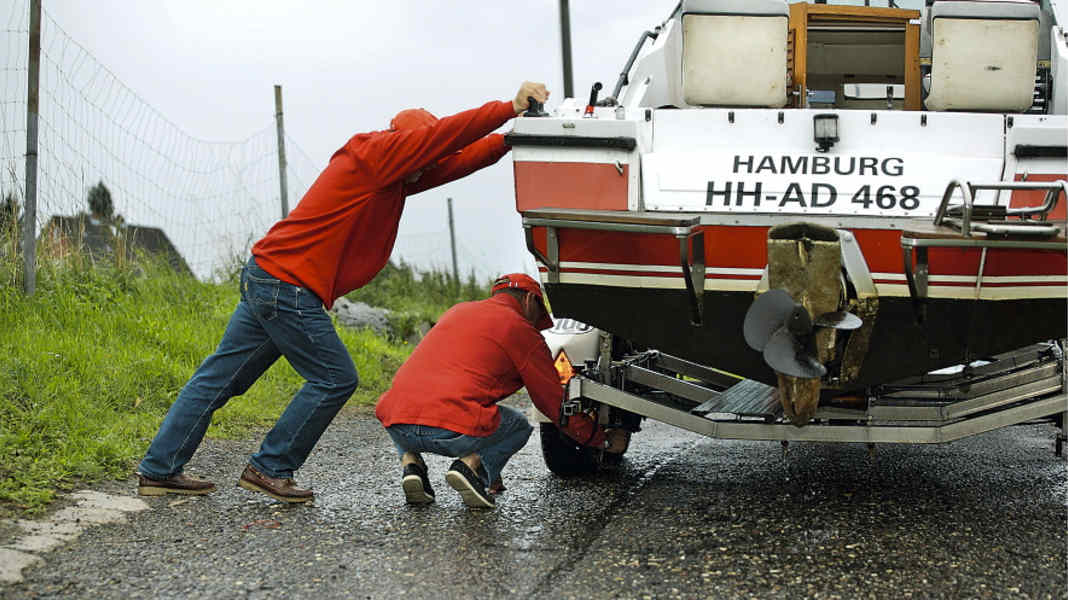
By boat from Hamburg to Berlin in six days? Or would you prefer six hours? Sure, the journey is the destination and leads on its own keel via the Elbe, the Elbe-Havel Canal and the Lower Havel Waterway through lots of nature and cities such as Lauenburg, Magdeburg and Potsdam. Meanwhile, the trailer captain is stuck in a traffic jam at the Wittstock/Dosse motorway junction. Or not.
In any case, he arrives at his destination much faster than his "colleague inland skipper". What's more, if he wants to, he can be relaxing in the sun on his boat off the coast of Croatia or in Niendorf on the Baltic Sea just a few days later. Provided he has adhered to the most important "rules of the game" when travelling by road. Our trailer ABC reveals what you need to bear in mind when travelling with a trailer and how to get to your destination safely and comfortably.
PART 3: ANTI-THEFT DEVICE - KEEL ROLLERS
ANTI-THEFT DEVICE
Every trailer driver should secure their trailer adequately against "thieves". Otherwise they run the risk of losing their insurance cover in the event of theft. The best protection is a safety device that can be used when the trailer is attached and detached as well as when driving. Axle manufacturers such as AL-KO and accessory dealers offer such locks.
DRIVER'S CERTIFICATE
Which driving licence do I need if I want to drive a car and trailer combination? The answer to this question would go beyond the scope of this issue. Therefore, we will deal with this topic in the next issue of BOOTE.
DANGEROUS GOODS
In principle, the transport of diesel and petrol by road is a transport of dangerous goods.
However, exemptions must be observed. For example, for the transport of dangerous goods carried by private individuals - provided that these goods are packaged for retail sale and are intended for personal or domestic use or for leisure and sport, provided that measures are taken to prevent the contents from being released under normal transport conditions.
If these goods are flammable liquid substances that are transported in refillable containers filled by or for private individuals, the total quantity must not exceed 60 litres per container and 240 litres per transport unit. Tanks are therefore not considered to be "packaged for retail sale".
Nevertheless, the following applies in practice: if a tank is permanently installed in the boat, it can be full during transport. If you have to reckon with every kilo - and who doesn't have to - you will do without a full tank and reserve canister when trailering anyway.
SPEED
In Germany, the maximum speed for car-trailer combinations is set at 80 km/h. If the towing vehicle and trailer meet the technical requirements described in the 9th Exemption Ordinance to the German Road Traffic Regulations and these have been tested and documented by a monitoring organisation such as TÜV, DEKRA or GTÜ (entry in the vehicle documents, sticker), it is permitted to drive at 100 km/h on motorways and motorways. Abroad, however, the regulations of the respective country always apply.
GREEN INSURANCE CARD
With a few exceptions (Eastern Europe), a green insurance card is no longer compulsory when travelling abroad. However, insurance companies still recommend the "green card". If you have it with you, it makes it much easier to deal with an accident abroad. Since trailers have been required to have their own licence plate (1992), they also need their own insurance card. Of course, this is only available if you have taken out your own insurance for the trailer (see Insurance).
HEIGHT OF THE LOAD
The maximum permissible height for loads in Germany and other European countries is limited to 4 metres. It is possible to obtain a special permit, but the conditions are so extensive that it is better to leave such transport to the professionals.
IDENTIFICATION
Sports trailers - including boat trailers - are not subject to tax or insurance, but have had to have their own licence plate since 1992. The licence plate can be obtained from the registration office.
KIELROLLEN
Keel rollers are load-bearing elements and should therefore be adapted exactly to the keel of the boat. The rollers and their shafts must be checked for damage and ease of movement at least once a year.
A tip: The yellow keel rollers made of polyurethane are much more robust, turn much more easily than their black rubber counterparts and are therefore the first choice for anyone who slips a lot.

